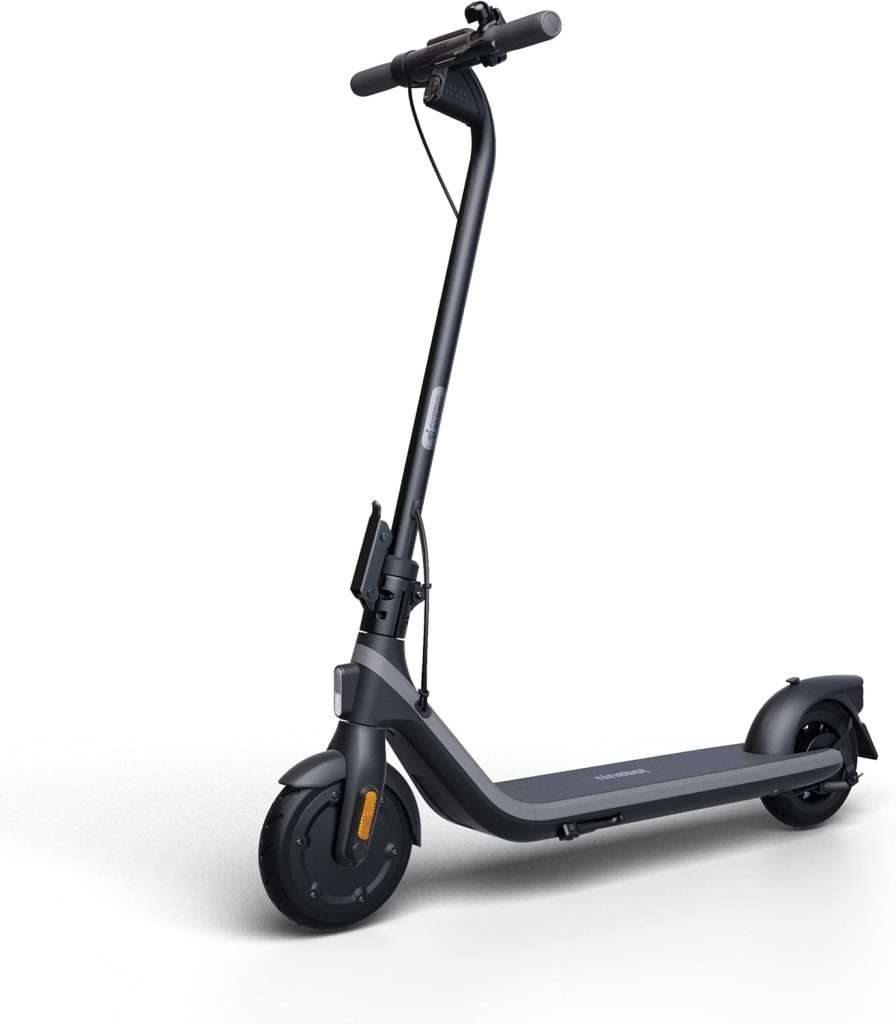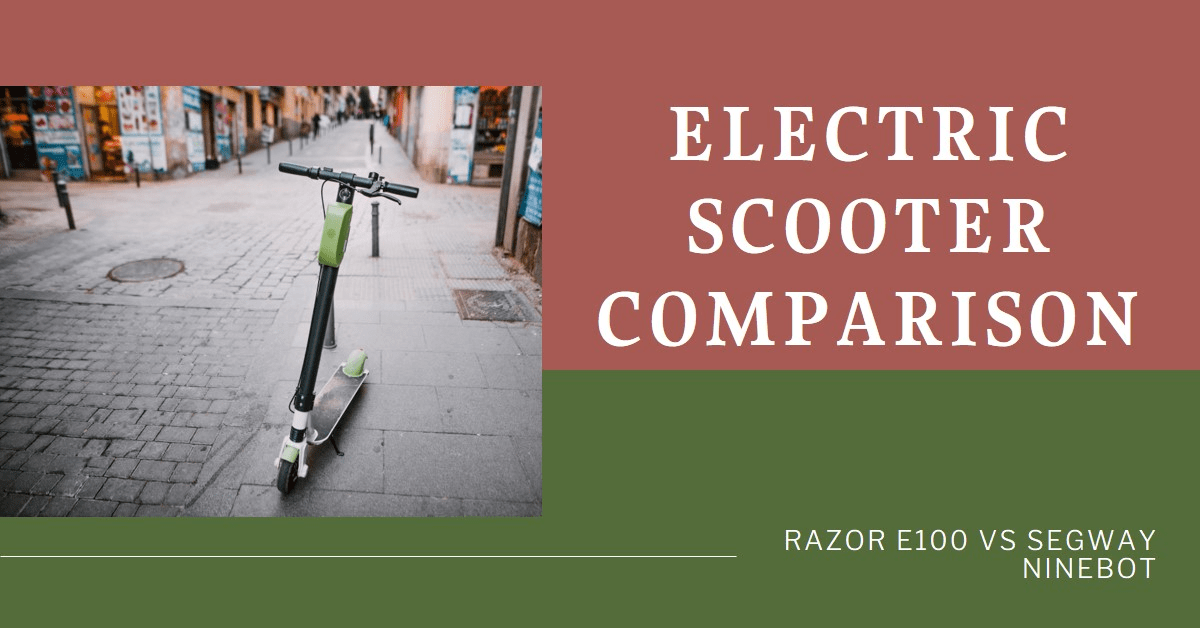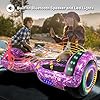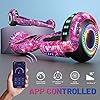SIMATE Scooter, Bluetooth & Corlorful LED Lights, Gifts for Kids & Adults & Girls & Boys, for All Ages
$129.99 (as of July 26, 2024 04:58 GMT +00:00 - More infoProduct prices and availability are accurate as of the date/time indicated and are subject to change. Any price and availability information displayed on [relevant Amazon Site(s), as applicable] at the time of purchase will apply to the purchase of this product.)WAYPLUS Kick Scooter for Ages 6+,Kid, Teens & Adults. Max Load 240 LBS. Foldable, Lightweight, 8IN Big Wheels for Kids, Teen and Adults, 4 Adjustable Levels. Bearing ABEC9
$79.99 (as of July 26, 2024 16:09 GMT +00:00 - More infoProduct prices and availability are accurate as of the date/time indicated and are subject to change. Any price and availability information displayed on [relevant Amazon Site(s), as applicable] at the time of purchase will apply to the purchase of this product.)Electric scooters offer a fun and environmentally friendly mode of transportation for brief commutes and city travel. Razor E100 and Segway Ninebot are two well-liked electric scooter models among people of all ages.
But how do these two scooters compare when it comes to speed, range, features and overall performance? This comprehensive analysis will contrast the Razor E100 and the Segway Ninebot in every respect, enabling you to determine which is more suitable for your requirements.
Comfort, portability, ride quality, and battery life will all be discussed, among other things. You will know precisely which of these electric rideables fits your lifestyle and budget the best by the end. Let’s get started!
Overview and Specs
To kick things off, let’s look at an overview and key specs for each scooter model:
Razor E100

- Top speed: 10 mph
- Range: 40 min continuous use
- Motor: 100W chain-driven
- Battery: 24V sealed lead acid
- Charge time: 12 hours
- Weight: 29 lbs
- Load capacity: 120 lbs
- Wheels: 8” pneumatic tires
- Brakes: Hand operated rear brake
- Age: 8+ years
Segway Ninebot

- Top speed: 10 mph
- Range: 13.7 miles
- Motor: 300W hub motor
- Battery: 28.8V lithium ion
- Charge time: 6 hours
- Weight: 28 lbs
- Load capacity: 220 lbs
- Wheels: 9” pneumatic tires
- Brakes: Electric + foot brake
- Age: 16+ years
Both the E100 and Ninebot max out at a top speed of 10mph, but the Ninebot has over triple the range at 13.7 miles vs only 40 minutes for the Razor. The Segway also uses a more powerful lithium ion battery that recharges faster than the E100’s lead acid battery.
On the contrary, with a lighter weight and a lower minimum recommended age, the Razor E100 may be more appropriate for motorcyclists in their youth.
Ride Quality and Performance
Ride comfort, smoothness, acceleration and overall performance significantly impact how enjoyable an electric scooter is to use. In terms of ride quality in the actual world, the Razor E100 and Segway Ninebot models are comparable as follows:
Acceleration and Responsiveness
The E100 offers solid low end torque, allowing it to accelerate from 0 to 10mph in about 10 seconds. Throttle response feels consistent and predictable. However, the chain driven motor can feel slightly noisy.
The operation of the Segway Ninebot is reduced to a whisper through the use of a hub motor. The acceleration feels remarkably seamless. Six seconds is all it takes for the Ninebot to accelerate to a maximum of 10 mph due to its higher amperage motor. In general, the throttle and power delivery feel more refined than on the E100.
Handling and Stability
Riders report the Razor E100 feels stable and easy to maneuver at lower speeds thanks to its wide pneumatic tires. But it can feel wobbly over 10mph. At 29 pounds in weight, the E100 lacks the planted sensation associated with heavier scooters.
The Segway Ninebot, on the other hand, provides exceptional maneuverability and stability at maximum speed. It is equipped with knee steering and superior suspension for controlled cornering and bump absorption, even at high velocities, despite its relatively light weight of 28 pounds.
Comfort and Smoothness
Although it offers sufficient capacity, the E100’s 100W motor lacks the sophistication of the Ninebot’s. Vibration from the chain mechanism can transmit up the handlebars. Additionally, the firm deck is poor at absorbing impacts. Overall comfort is passable but not exceptional.
Comfort is a major strength on the Ninebot. For an exceptionally smooth ride, the combination of the front and rear shock absorption and the large air-filled tires allows for effortless movement over cracks and potholes. With the knee steering bar and kickstand, riding is effortless and requires little effort.
Braking
The primary source of stopping power for the Razor E100 is a manually operated rear brake. It works adequately but lacks engine braking. Squeezing too hard can lock up the rear wheel under hard braking.
For redundancy, the Ninebot is equipped with both an electric motor brake and a mechanical rear foot brake. Braking feels considerably more linear and controlled. Large tires offer sufficient traction for a progressive deceleration without skidding.
Hill Climbing
Thanks to its chain driven motor, the E100 can tackle inclines of up to 10% grade. Its 100W power output challenges on steeper inclines, necessitating the use of kicking assistance. Overall hill climbing capability is moderate.
The Segway Ninebot delivers 300W of continuous power allowing it to motor smoothly up 20% grades with a full size adult rider. Bicycling or kicking is unnecessary, even on precipitous urban hills. The efficacy on inclines is significantly superior to that of the E100.
Battery Life and Charging
Range anxiety is one of the biggest concerns for any electric rideable owner. The batteries and overall range of the Segway Ninebot and Razor E100 scooters are comparable as follows:
Battery Type
The E100 uses a 24V sealed lead acid battery. This is an older, more affordable battery technology that has a few drawbacks in comparison to lithium ion. Lead acid batteries are more capaciously depleted over time, are bulkier, and weigh more.
Conversely, the Ninebot operates on a lithium ion battery cell with a substantial capacity of 28.8V. Li-ion batteries offer the benefits of lighter weight, smaller size, faster charging, and longer overall lifespan. The Ninebot unquestionably emerges successful in the realm of battery technology.
Range
Razor advertises “up to 40 minutes of continuous use” per charge. However, range depends greatly on rider weight, speed, and hills. Smaller kids may achieve over an hour of moderate riding. Significantly less range will be available to larger riders at maximum speed.
The Segway Ninebot is estimated to offer 13.7 miles per charge. In practice, reviews estimate distances of 10 to 15 miles, contingent upon the terrain and riding manner. This is equivalent to more than five times the E100’s mileage!
Charging Time
The E100’s lead acid battery requires a lengthy 12 hours to recharge from empty back to a full charge. This severely limits how often you can ride per day and means leaving it plugged in overnight.
Fast charging technology allows the lithium battery of the Ninebot to be fully recharged in as little as four hours. Since the majority of motorcyclists will not completely deplete the battery in a single day, overnight charging is adequate for daily use.
Battery Life
Lead acid batteries steadily lose capacity as they are charged repeatedly. It is common for the battery life of E100s to decrease after one to two years, resulting in an even shorter range per charge. Eventually the battery will need replacement.
In comparison, lithium ion batteries maintain consistent range for years and through 500+ charging cycles before capacity fades noticeably. Expect the Ninebot battery to last exponentially longer before needing replacement.
ride1 Ride Quality/Performance
| Metric | Razor E100 | Segway Ninebot |
|---|---|---|
| Acceleration/Responsiveness | Moderate, noisy chain motor | Very fast, quiet acceleration |
| Handling/Stability | Stable at low speeds, gets wobbly | Excellent handling up to top speed |
| Comfort/Smoothness | Passable, vibrations transmit through bars | Extremely smooth suspension and tires |
| Braking | Rear hand brake only | Regenerative braking + foot brake |
| Hill Climbing | Up to 10% grade inclines | Up to 20% grades easily |
ride2 Battery/Range
| Metric | Razor E100 | Segway Ninebot |
|---|---|---|
| Battery Type | 24V sealed lead acid | 28.8V lithium ion |
| Max Range | 40 min continuous use | 13.7 miles per charge |
| Recharge Time | 12 hours | 4-6 hours |
| Battery Lifespan | Declines after 1-2 years | 500+ cycles over several years |
Portability
Being able to easily transport your electric scooter is key for many owners. Here is how the portability and folding mechanisms of the E100 and Ninebot compare:
Weight
At just 29 lbs, the Razor E100 is one of the lightest electric scooters around. Kids and smaller teens will find it easy to maneuver while heavier adults can still pick it up reasonably well. The weight keeps it from feeling bulky.
The Ninebot weighs 28 lbs – so it’s nearly identical to the E100 in heft. This moderately light weight allows most riders to carry it short distances or bring it up stairs with little trouble.
Folding
The E100 does not have a folding mechanism. The handlebars are fixed and the deck is a single piece. You cannot collapse it smaller to store in a car or on public transportation easily.
In contrast, the Segway Ninebot features an easy one-step folding system. The handlebar and knee steering bar fold in, decreasing its footprint immensely for transport and compact storage.
Carrying
When it comes time to move the E100, there are no convenient built-in carrying handles. You mainly need to awkwardly grab the handlebars and lift by the deck. Bringing it up stairs or onto buses can be challenging.
Integrated carrying handles underneath the Ninebot deck allow you to heft it by the sturdy middle. This makes maneuvering up stairs or steps much easier. The one handed carrying style is ideal for bringing it on public transit.
Storage
Without folding capability, the E100 takes up considerable floor space. It may fit in larger car trunks but not easily in back seats. Storing in a closet is also a tight squeeze.
Thanks to its ability to fold down nearly in half, the Ninebot can fit nicely in many car trunks, SUV cargo areas, back seats and reasonably sized closets or corners. The folding design is vastly more storage friendly.
Comfort and Ergonomics
Ride feel and ergonomics determine how comfortable an electric scooter will be over extended outings:
Deck Size
The Razor E100 has a deck measuring about 7.5” wide by 21” long. The limited standing space feels cramped for larger adult shoes. Kids and smaller teens will find it adequate.
At 15” wide, the Ninebot more than doubles the usable deck space of the E100. Even adults with large shoe sizes have ample room to find a stable footing and stance. The deck size difference is substantial.
Deck Texture
The E100 features a basic, flat plastic foot deck that can become rather slippery if damp. It lacks extensive texturing for grip. Riders may want to modify it with skateboard grip tape for better traction.
In contrast, the large Ninebot deck incorporates molded-in grip texture and a kick guard in the back. This helps shoes “lock in” safely even when the deck gets wet. The deck molding shows much more attention to ergonomics.
Suspension
Unfortunately the beginner level E100 lacks any built-in suspension or shock absorption. Only the air filled tires provide minimal impact damping. Expect to feel every crack and bump through the handlebars and floorboard.
The Ninebot sets itself apart with front and rear spring shock suspension for an exceptionally smooth ride. The integrated suspension soaks up bumps that would jar and rattle riders on a non-suspended scooter. The difference is remarkable.
Handlebars
On the E100, handlebar height is not adjustable. At 34” they work acceptably for older kids and teens plus shorter adults. Tall riders may find them uncomfortably low. Grips are basic rubber pads.
Height adjustable handlebars allow riders from 4’5” up to 6’5” to dial in the perfect height on the Segway Ninebot. The ergonomic grips stay comfortable even during long rides.
Features and Customization
Both scooters provide certain convenience features that improve the overall functionality:
Speed Settings
The Razor E100 allows adjusting the maximum speed via an under deck switch. It can be changed between 10mph, 12mph and 15mph to match rider skill level. Parents can limit speed for beginners learning.
While the Ninebot maxes out at 10mph, it offers three speed modes also adjustable via an easy button. Beginners can start in the 4 mph mode and work up from there as skills improve. The speed adjustment options are very comparable.
Kickstart
The E100 is equipped with a practical kick-start function. You simply kick off a couple times to get rolling then throttle up smoothly to engage the electric motor. This allows you to conserve battery if desired.
Additionally, the Ninebot can be started by performing a “kickstart” motion prior to adjusting the throttle. This allows riding with 100% electric power or alternating kicking and coasting to save battery when desired.
Cruise Control
Cruise control lets you lock in your desired speed hands-free. This practical feature is regrettably absent from the base Razor E100 model. You must maintain thumb pressure on the throttle to keep moving.
On the other hand, the Ninebot is outfitted with a cruise control button that enables precise speed settings followed by autonomous speed maintenance. This is a tremendous benefit when you need to relax your right hand during lengthy straightaways.
Customization
Altering the appearance of the E100 is confined in scope. You can add grip tape, stickers or paint details but not much else. Parents may want to add reflective side bands for visibility.
Segway provides owners with an extensive selection of fashionable accessories that can be used to personalize their Ninebot. Carbon fiber accents, colored rims, add-on lights, and storage bags are among the available options. The possibilities are endless!
Warranty and Support
Warranty coverage when purchasing an electric vehicle offers reassurance in the event that any defects occur:
Warranty Comparison
- There is a 90-day limited warranty on the E100 frame. The electrical components are covered for 6 months from the purchase date.
- On the other hand, Segway offers a limited warranty of one year that covers manufacturing defects encompassing both the electrical components and the frame.
Customer Support
- Communicating with Razor support may present challenges, as evidenced by a multitude of customer reviews that highlight difficulties in receiving replies from support staff.
- Segway earns high marks for customer service responsiveness. Contact their support team through live online chat, phone, or email to receive prompt resolutions to any issues that may arise.
In conclusion, the Ninebot frame is backed by a one-year warranty as opposed to the E100 frame’s 90 days. Additionally, Segway is widely regarded for its exceptional customer service support when required.
Cost Comparison
Obviously, price is a significant factor when deciding between the Segway Ninebot and Razor E100 electric scooters. The following compares their MSRP and overall value:
Base Price
- Razor E100: MSRP $120-$180 depending on retailer
- Segway Ninebot: MSRP $559 on Segway.com
There is no contest when it comes to upfront purchase price. The E100 can readily be found for under $150 in many cases, making it very budget friendly. Meanwhile the Ninebot costs over 3 times as much at its $559 MSRP price.
The price disparity is, nevertheless, somewhat narrowed by the availability of Ninebot discounts during promotions on Amazon and other retailers.
Value Comparison
Most riders conclude that the Ninebot’s significantly longer battery life, more consistent power delivery, suspension, and overall superior quality more than compensate for its higher initial cost.
The saying “you get what you pay for” definitely applies here. In terms of comprehensive ownership experience, the Ninebot significantly exceeds that of the E100. For serious electric scooter enthusiasts, the extra upfront investment pays for itself through exceptional performance and durability.
However, parents on a limited budget who are looking for an entry-level e-scooter can effectively assess their children’s interest and responsiveness with the E10
riders1 Features
| Feature | Razor E100 | Segway Ninebot |
|---|---|---|
| Speed Settings | 10/12/15 mph switch | Beginner/Standard/Sport button |
| Kickstart | Yes | Yes |
| Cruise Control | No | Yes |
| Customization | Limited | Extensive accessory options |
riders2 Warranty/Support
| Comparison | Razor E100 | Segway Ninebot |
|---|---|---|
| Frame Warranty | 90 days | 1 year |
| Electronics Warranty | 6 months | 1 year |
| Customer Support | Mixed reviews | Excellent reviews |
Key Takeaways
- Under $200 and capable of 10 mph, the Razor E100 is an excellent option for younger novice motorcyclists on a budget. But its limited battery life, lack of suspension, and basic features leave room for improvement.
- Riding the Segway Ninebot provides an exceptionally smoother, more extensive range. Its premium price is justified by exceptional battery life, maneuverability, and cruise control, which further reassure serious scooter devotees.
- Carefully evaluate your budget, requirements, and intended cycling objectives. For short neighborhood jaunts, the E100 should suffice. But the Ninebot is vastly superior for daily commuting or exploring further afield.
- Although initially more expensive, the Ninebot reduces operating expenses due to less frequent recharging. Plus its good warranty and customer service provide peace of mind down the road.
In conclusion, although the E100 is a commendable entry-level scooter suitable for children, the Segway Ninebot emerges victorious on account of its exceptional range, refined suspension, and superior build quality. By making an additional investment in the Ninebot, you acquire an electric scooter that will serve as a pleasurable mode of daily transportation for many years, as opposed to being a disposable novelty.

I’m the founder of HoverboardsGuide.com, a comprehensive website dedicated to electric scooters and hoverboards. With a deep-rooted passion for electric gadgets, I’ve accumulated extensive experience in this field. I aim to assist users in selecting the best gadgets and providing reliable guidance.
I’ve tested and reviewed numerous models, gaining in-depth knowledge about their features, performance, and overall quality. Feel free to reach out to me with any queries, as I’m dedicated to addressing your concerns promptly. Join me on this exciting journey of exploring the world of electric rides and making informed decisions

























